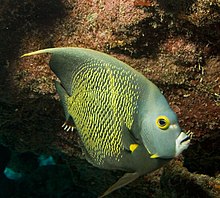French angelfish
| French angelfish | |
|---|---|

| |
| Scientific classification | |
| Domain: | Eukaryota |
| Kingdom: | Animalia |
| Phylum: | Chordata |
| Class: | Actinopterygii |
| Order: | Perciformes |
| Family: | Pomacanthidae |
| Genus: | Pomacanthus |
| Species: | P. paru
|
| Binomial name | |
| Pomacanthus paru (Bloch, 1787)
| |
| Synonyms[2] | |
| |
The French angelfish (Pomacanthus paru) is a species of marine
Description

The French angelfish has a laterally compressed body which is almost circular in shape. The head is deep with a short snout ending in a small mouth which contains numerous bristle-like teeth. There is an obvious spine at the corner of the
Distribution
The French angelfish is found in the western
Habitat and biology
The French angelfish is found at depths between 3 and 100 m (9.8 and 328.1 ft). It is common on rocky and coral reefs where it is normally encountered in pairs, frequently in the vicinity of sea fans. Its diet comprises
The pair normally swim a short distance above the reef. There are no obvious courtship displays or clear sexual dimorphism. At dusk, the pair swam upwards in a wide, shallow curve from the substrate, travelling around 7 to 10 m horizontally as they climb to a 2 or 3 m (6 ft 7 in or 9 ft 10 in). As they ascend, both angle their bodies slightly, with their vents very close together, even touching. They hold this posture throughout the zenith of their curve separating as they descend. Neighbouring pairs were observed undertaking similar movements above the reef at roughly the same time. The observers were unable to ascertain if
Systematics
The French angelfish was first formally described as Chaetodon paru by the
Utilisation
The French angelfish is common in the
References
- ^ . Retrieved 20 November 2021.
- ^ a b c d e f Froese, Rainer; Pauly, Daniel (eds.) (2019). "Pomacanthus paru" in FishBase. December 2019 version.
- ^ "Species: Pomacanthus paru, French angelfish". Shorefishes of the Greater Caribbean online information. Smithsonian Tropical Research Institute. Retrieved 3 March 2021.
- ^ "Pomacanthus paru". Saltcorner!. Bob Goemans. 2012. Retrieved 3 March 2021.
- ^ "Pomacanthus paru (French Angelfish)". Animal Diversity Web.
- ^ Globe Rover. "French Angelfish". Globe Rove. Retrieved 2013-07-09.
- ^ a b "Pomacanthus paru". reefapp.net. Retrieved 3 March 2021.
- ^ Eschmeyer, William N.; Fricke, Ron & van der Laan, Richard (eds.). "Species in the genus Pomacanthus". Catalog of Fishes. California Academy of Sciences. Retrieved 3 March 2021.
- ^ Christopher Scharpf & Kenneth J. Lazara (21 July 2020). "Order ACANTHURIFORMES (part 1): Families LOBOTIDAE, POMACANTHIDAE, DREPANEIDAE and CHAETODONTIDAE". The ETYFish Project Fish Name Etymology Database. Christopher Scharpf and Kenneth J. Lazara. Retrieved 27 February 2021.
External links
- Video of a Juvenile French Angelfish (Pomacanthus paru)—Jim W. Arch 19:15, 20 May 2014 (UTC)
- Salty Endeavors discussed the French Angelfish juvenile compared to a Grey Angelfish juvenile-Henry S.
- Photos of French angelfish on Sealife Collection

